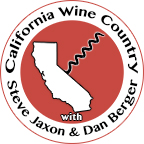Podcast: Play in new window | Download (Duration: 35:03 — 16.2MB) | Embed
Subscribe: Apple Podcasts | RSS | More
Alan Baker, co-founder of Cartograph Wines, joins Steve Jaxon and Dan Berger on California Wine Country today. They taste three wines: a Cartograph 2013 Brut Rosé Sparkling Wine, a single vineyard Pinot Noir and a blended Pinot Noir.
Their first tasting is Cartograph’s first sparkling wine, a brut rosé, with almost all Chardonnay and 1.5% Pinot for the salmon color, and a small amount of sugar in the dosage. Steve finds it “adorable.” Dan Berger says it has terrific acidity as every good bubbly wine should have. He notes that the Pinot flavor actually comes through, even if in such a small amount. Alan Baker explains that they made the base wine of Chardonnay then separated half of the grapes to make this sparkling wine, and with the rest of the wine, they added no additions and no dosage and call it “brut zero.” Steve asks Dan to explain dosage, a French term for the sugar addition just before putting the cork into the bottles.
 Alan Baker and Serena Lourie founded Cartograph. Alan worked for 17 years as a radio engineer in Minnesota. He tells about his taste of a 1998 Alsace Riesling that set him off researching wine. He was so interested in wine that he moved to Healdsburg and got some jobs in wineries. He started a wine blog and an audio podcast and he promised his employers that the podcast would promote their wineries. Then NPR picked up the podcast, so that helped him get great guests. It’s called The Cellar Rat. (The blog runs from April 2005 to May 2010, right up to when he released his first Cartograph wines. The blog is a record of his exporations, learning and achievement over those years and is still available at the website. Some audio episodes are also available on various platforms.) His first production was 100 cases of Pinot that he sold as futures to his podcast and blog audience. That is how he funded his first vintage. After his first wine was made, Alan got hired to work at Crushpad. He has also taken continuing education classes at UC Davis.
Alan Baker and Serena Lourie founded Cartograph. Alan worked for 17 years as a radio engineer in Minnesota. He tells about his taste of a 1998 Alsace Riesling that set him off researching wine. He was so interested in wine that he moved to Healdsburg and got some jobs in wineries. He started a wine blog and an audio podcast and he promised his employers that the podcast would promote their wineries. Then NPR picked up the podcast, so that helped him get great guests. It’s called The Cellar Rat. (The blog runs from April 2005 to May 2010, right up to when he released his first Cartograph wines. The blog is a record of his exporations, learning and achievement over those years and is still available at the website. Some audio episodes are also available on various platforms.) His first production was 100 cases of Pinot that he sold as futures to his podcast and blog audience. That is how he funded his first vintage. After his first wine was made, Alan got hired to work at Crushpad. He has also taken continuing education classes at UC Davis.
Dan Berger mentions the competition for fruit in Sonoma County, where everyone wants Pinot Noir. He had to plant some of his own vines to have a steady supply. That’s important for a consistent production. He makes Gewürztraminer and Riesling.
Next they taste a 2016 Pinot Noir, made from a single clone, the 777 clone, from their estate property. In Spring 2018 they released single clone wines. They also make an estate blend. Dan Berger thinks this wine is way too young, and it has depth and an intense mid-palette, which he thinks will benefit from about 10 years.
Cartograph sells almost all of their wine direct to consumer and through their wine club. Alan Baker is grateful for their strong local following and the many wine industry people who purchase their wines.
Dan Berger says that this is the first taste of the 2016s and it is impressive. Of course it can be decanted which makes up for less aging. Cabernet Sauvignon used to be on a 4½ year cycle, now it’s 2½ which is too young.
Alan explains the name Cartograph and the label, which represents a globe with five locations where he and his wife had their most important formative wine experiences.
Dan asks Alan about how he chose the varieties he works with, especially the cooler climate white wines.
This next Pinot Noir is another blended wine, which Dan says is quite complex and not as explosive as other similar wines at similar high prices. The lower alcohols do allow the fruit tendencies to jump out more. He also says that the spice component will be lost in 6-10 years and the flavors will be stronger.
Dan says that Alan captures natural varietal character as well as the vineyard character. Alan says that his job is to act as a shepherd rather than a heavy-handed winemaker intervening all over the process.
This is the first year they released wines from their estate vineyard. They are embarking on a replanging program to match their vines to their location. Dan talks about a general overall trend in climate change, with general increasing temperatures, but there are some cooler years and aberrational years.

